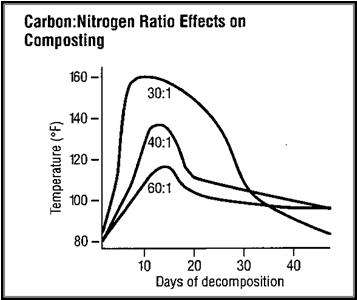This posting gives you an idea of using the right combination of fertilzer to achieve optimal results
There are some essential factors involved in determining what type of pile to build and how to manage the feedstocks. Organisms cannot decompose organic material as efficiently without certain requirements, such as air, water and appropriate particle size. Following are the most important considerations.
carbon-nitrogen relationships
The course of decomposition of organic matter is affected by the presence of carbon and nitrogen. The C:N ratio represents the relative proportion of the two elements. A material, for example, having 25 times as much carbon as nitrogen is said to have a C:N ratio of 25:1, or more simple, a C:N ratio of 25. Actually, the ratio of available carbon to available nitrogen is the important relationship because there may be some carbon present so resistant to biological attack that its presence is not significant.
Organisms that decompose organic matter use carbon as a source of energy and nitrogen for building cell structure. They need more carbon than nitrogen. If there is too much carbon, decomposition slows when the nitrogen is used up and some organisms die. Other organisms form new cell material using their stored nitrogen. In the process more carbon is burned. Thus the amount of carbon is reduced while nitrogen is recycled. Decomposition takes longer, however, when the initial C:N ratio is much above 30.

In the soil, using organic matter with excess carbon can create problems. To complete the nitrogen cycle and continue decomposition, the microbial cells will draw any available soil nitrogen in the proper proportion to make use of available carbon. This is known as "robbing" the soil of nitrogen, and delays availability of nitrogen as a fertilizer for growing plants until some later season when it is no longer being used in the life-cycles of soil bacteria.
When the energy source, carbon, is less than that required for converting available nitrogen into protein, organisms make full use of the available carbon and get rid of the excess nitrogen as ammonia. This release of ammonia to the atmosphere produces a loss of nitrogen from the compost pile and should be kept to a minimum.
A C:N ratio of 20, where C and N are the available quantities, is the upper limit at which there is no danger of robbing the soil of nitrogen. If a considerable amount of carbon is in the form of lignin or other resistant materials, the actual C:N ratio could be larger than 20. The C:N ratio is a critical factor in composting to prevent both nitrogen robbing from the soil and conserving maximum nitrogen in the compost..
Since organisms use about 30 parts carbon for each part of nitrogen, an initial C:N (available quantity) ratio of 30 promotes rapid composting and would provide some nitrogen in an immediately available form in the finished compost. Researchers report optimum values from 20 to 31. A majority of investigators believe that for C:N ratios above 30 there will be little loss of nitrogen. University of California studies on materials with a initial C:N ratio varying from 20 to 78 and nitrogen contents varying from 0.52% to 1.74% indicate that initial C:N ratio of 30 to 35 was optimum. These reported optimum C:N ratios may include some carbon which was not available. Composting time increases with the C:N ratio above 30 to 40. If unavailable carbon is small, the C:N ratio can be reduced by bacteria to as low a value as 10. Fourteen to 20 are common values depending upon the original material from which the humus was formed. These studies showed that composting a material with a higher C:N ratio would not be harmful to the soil, however, because the remaining carbon is so slowly available that nitrogen robbery would not be significant.
CARBON NITROGEN (C:N) RATIOS IN FEEDSTOCKS
Plant residues are made up largely of the following:
1. sugar, starch, simple proteins (decompose rapidly)
2. crude protein (decompose slowly)
3. hemicellulose (decompose slowly)
4. cellulose (decompose slowly)
5. lignin, fat, wax, etc. (decompose slowly)
Rate of decay and release of nutrients to the soil vary greatly. Likewise, demands of living soil microorganisms vary as they "break down" plant residue. Sawdust (made primarily of lignin and cellulose) uses vast amounts of energy to maintain the lives of microorganisms digesting it. A major product of plant decay is nitrogen (N) while the undigested portion is primarily carbon (C).
The optimum ratio in soil organic matter is about 10 carbons to 1 nitrogen, or a C:N ratio of 10:1.
Following are some sample C:N ratios of organic matter:
Sandy loam (fine) 7:1
Humus 10:1
Food scraps 15:1
Alfalfa hay 18:1
Grass clippings 19:1
Rotted manure 20:1
Sandy loam (coarse) 25:1
Vegetable trimmings 25:1
Oak leaves 26:1
Leaves, varies from 35:1 to 85:1
Peat moss 58:1
Corn stalks 60:1
Straw 80:1
Pine needles 60:1 to 110:1
Farm manure 90:1
Alder sawdust 134:1
Sawdust weathered 3 years 142:1
Newspaper 170:1
Douglas fir bark 491:1
Sawdust weathered 2 months 625:1





No comments:
Post a Comment